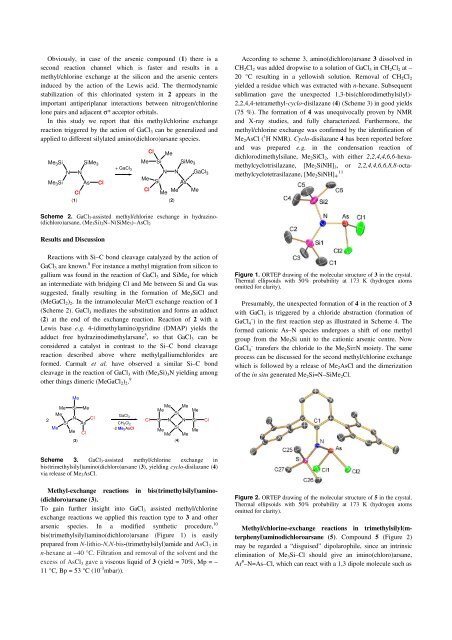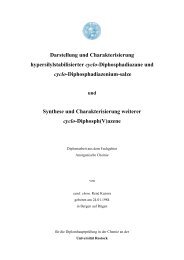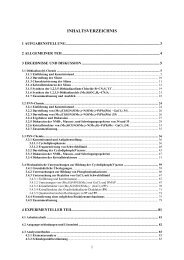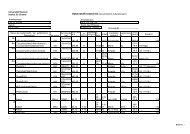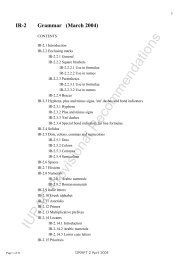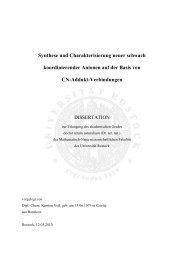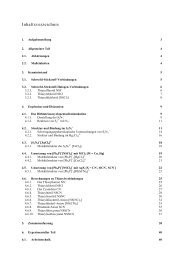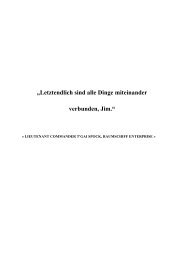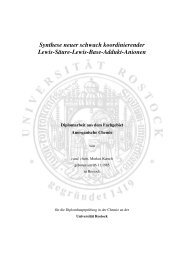Darstellung und Charakterisierung neuer niedrigkoordinierter ...
Darstellung und Charakterisierung neuer niedrigkoordinierter ...
Darstellung und Charakterisierung neuer niedrigkoordinierter ...
Create successful ePaper yourself
Turn your PDF publications into a flip-book with our unique Google optimized e-Paper software.
Obviously, in case of the arsenic compo<strong>und</strong> (1) there is a<br />
second reaction channel which is faster and results in a<br />
methyl/chlorine exchange at the silicon and the arsenic centers<br />
induced by the action of the Lewis acid. The thermodynamic<br />
stabilization of this chlorinated system in 2 appears in the<br />
important antiperiplanar interactions between nitrogen/chlorine<br />
lone pairs and adjacent σ* acceptor orbitals.<br />
In this study we report that this methyl/chlorine exchange<br />
reaction triggered by the action of GaCl3 can be generalized and<br />
applied to different silylated amino(dichloro)arsane species.<br />
Scheme 2. GaCl3-assisted methyl/chlorine exchange in hydrazino-<br />
(dichloro)arsane, (Me3Si)2N–N(SiMe3)–AsCl2<br />
Results and Discussion<br />
Reactions with Si–C bond cleavage catalyzed by the action of<br />
GaCl3 are known. 8 For instance a methyl migration from silicon to<br />
gallium was fo<strong>und</strong> in the reaction of GaCl 3 and SiMe 4 for which<br />
an intermediate with bridging Cl and Me between Si and Ga was<br />
suggested, finally resulting in the formation of Me3SiCl and<br />
(MeGaCl 2) 2. In the intramolecular Me/Cl exchange reaction of 1<br />
(Scheme 2). GaCl 3 mediates the substitution and forms an adduct<br />
(2) at the end of the exchange reaction. Reaction of 2 with a<br />
Lewis base e.g. 4-(dimethylamino)pyridine (DMAP) yields the<br />
adduct free hydrazinodimethylarsane 5 , so that GaCl 3 can be<br />
considered a catalyst in contrast to the Si–C bond cleavage<br />
reaction described above where methylgalliumchlorides are<br />
formed. Carmalt et al. have observed a similar Si–C bond<br />
cleavage in the reaction of GaCl3 with (Me3Si)3N yielding among<br />
other things dimeric (MeGaCl 2) 2. 9<br />
2<br />
Me 3Si<br />
Me 3Si<br />
Me<br />
Me<br />
Me<br />
Si<br />
N N<br />
Cl<br />
SiMe 3<br />
As Cl<br />
+ GaCl 3<br />
N N<br />
Scheme 3. GaCl3-assisted methyl/chlorine exchange in<br />
bis(trimethylsilyl)amino(dichloro)arsane (3), yielding cyclo-disilazane (4)<br />
via release of Me2AsCl.<br />
Methyl-exchange reactions in bis(trimethylsilyl)amino-<br />
(dichloro)arsane (3).<br />
To gain further insight into GaCl3 assisted methyl/chlorine<br />
exchange reactions we applied this reaction type to 3 and other<br />
arsenic species. In a modified synthetic procedure, 10<br />
bis(trimethylsilyl)amino(dichloro)arsane (Figure 1) is easily<br />
prepared from N-lithio-N,N-bis-(trimethylsilyl)amide and AsCl 3 in<br />
n-hexane at –40 °C. Filtration and removal of the solvent and the<br />
excess of AsCl3 gave a viscous liquid of 3 (yield = 70%, Mp = –<br />
11 °C, Bp = 53 °C (10 -3 mbar)).<br />
Me<br />
Me<br />
Cl<br />
Cl<br />
Si<br />
Si<br />
Me<br />
Me<br />
(1) (2)<br />
Si<br />
N<br />
Me<br />
Me<br />
Me<br />
As<br />
Cl<br />
Cl<br />
GaCl 3<br />
CH2Cl2 -2 Me2AsCl Me<br />
SiMe 3<br />
As<br />
GaCl 3<br />
Me<br />
Me Me<br />
Me Me<br />
Si<br />
N<br />
Me<br />
Me<br />
(3) (4)<br />
Cl<br />
Si<br />
Si<br />
N<br />
Me<br />
Si<br />
Me<br />
Cl<br />
According to scheme 3, amino(dichloro)arsane 3 dissolved in<br />
CH 2Cl 2 was added dropwise to a solution of GaCl 3 in CH 2Cl 2 at –<br />
20 °C resulting in a yellowish solution. Removal of CH2Cl2<br />
yielded a residue which was extracted with n-hexane. Subsequent<br />
sublimation gave the unexpected 1,3-bis(chlorodimethylsilyl)-<br />
2,2,4,4-tetramethyl-cyclo-disilazane (4) (Scheme 3) in good yields<br />
(75 %). The formation of 4 was unequivocally proven by NMR<br />
and X-ray studies, and fully characterized. Furthermore, the<br />
methyl/chlorine exchange was confirmed by the identification of<br />
Me 2AsCl ( 1 H NMR). Cyclo-disilazane 4 has been reported before<br />
and was prepared e.g. in the condensation reaction of<br />
dichlorodimethylsilane, Me2SiCl2, with either 2,2,4,4,6,6-hexamethylcyclotrisilazane,<br />
[Me 2SiNH] 3, or 2,2,4,4,6,6,8,8-octamethylcyclotetrasilazane,<br />
[Me 2SiNH] 4. 11<br />
Figure 1. ORTEP drawing of the molecular structure of 3 in the crystal.<br />
Thermal ellipsoids with 50% probability at 173 K (hydrogen atoms<br />
omitted for clarity).<br />
Presumably, the unexpected formation of 4 in the reaction of 3<br />
with GaCl3 is triggered by a chloride abstraction (formation of<br />
GaCl 4 – ) in the first reaction step as illustrated in Scheme 4. The<br />
formed cationic As–N species <strong>und</strong>ergoes a shift of one methyl<br />
group from the Me3Si unit to the cationic arsenic centre. Now<br />
GaCl 4 – transfers the chloride to the Me2Si=N moiety. The same<br />
process can be discussed for the second methyl/chlorine exchange<br />
which is followed by a release of Me2AsCl and the dimerization<br />
of the in situ generated Me 2Si=N–SiMe 2Cl.<br />
Figure 2. ORTEP drawing of the molecular structure of 5 in the crystal.<br />
Thermal ellipsoids with 50% probability at 173 K (hydrogen atoms<br />
omitted for clarity).<br />
Methyl/chlorine-exchange reactions in trimethylsilyl(mterphenyl)aminodichloroarsane<br />
(5). Compo<strong>und</strong> 5 (Figure 2)<br />
may be regarded a “disguised” dipolarophile, since an intrinsic<br />
elimination of Me 3Si–Cl should give an imino(chloro)arsane,<br />
Ar # –N=As–Cl, which can react with a 1,3 dipole molecule such as


